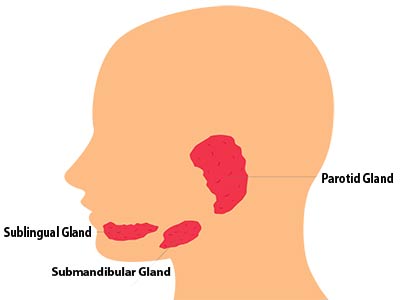
When you look down beautiful meal, you may have experienced a strange fluid taking over your mouth. That fluid is called saliva and comes from structures called salivary glands. A salivary gland is a secretory gland that secretes tasteless and clear saliva. It has many essential functions in the body, such as keeping the mucous membrane of the mouth moist. Salivary glands help us lubricate food. It also prevents tooth decay and is involved in the initial steps of digestion.
The salivary glands play an essential role in the body. There are both major glands and minor glands. The minor glands are located in and around the world cavity. It is estimated that 800 to thousand minor salivary glands are located within the mucous membrane lining of the mouth and tongue. However, these glands contribute less than 5% of the total saliva.
How does saliva work in the mouth?
Saliva is a complex fluid that facilitates lots of necessary functions. It lubricates our mouths, moistens food, assists digestion, protects teeth, and defends mouths from microorganisms. Here’s how saliva works:
Salivary Glands: The salivary glands in and around the mouth produce saliva. The major salivary glands include the parotid, submandibular, and sublingual glands. These glands secrete saliva into the mouth through small ducts.
Lubrication and Moistening: One of the primary functions of saliva is to lubricate and moisten the oral cavity, including the teeth, gums, tongue, and inner lining of the mouth. Saliva helps to prevent dryness, making it easier to speak, chew, and swallow.
Enzymes and Digestion: Saliva contains enzymes that initiate the process of digestion. The enzyme amylase, known as ptyalin, begins breaking down complex carbohydrates into simpler sugars. This process starts in the mouth and continues as the food passes through the digestive system.
Taste and Sensation: Saliva helps in taste perception by dissolving food particles, allowing them to interact with taste buds on the tongue. It facilitates the detection of sweet, sour, salty, bitter, and umami tastes.
pH Balance and Oral Health: Saliva helps maintain the pH balance in the mouth. It acts as a buffer, neutralizing acids produced by bacteria and reducing the risk of tooth decay and erosion. Saliva also contains antimicrobial properties that help control harmful bacteria and prevent infections.
Oral Cleansing: Saliva aids in the natural cleansing and rinsing of the mouth. It washes away food particles and debris, reducing bacteria and plaque buildup on the teeth and gums.
Wound Healing: Saliva contains substances that can promote wound healing. It can help protect and soothe minor injuries in the mouth, such as cuts or ulcers, and contribute to the healing process.
A group makes saliva from cells called salivary glands that deliver it into mouths through ducts. The body secretes between one and one and a half liters of saliva a day, and saliva is composed of about 99.5% water. Other components of saliva include electrolytes, digestive enzymes, metabolic wastes, and antibacterial elements.
There are three major salivary glands:
- The parotid glands.
- The submandibular glands.
- The sublingual glands.
There are four types of minor glands:
- Buccal glands are located in the cheeks.
- Lingual glands are located on the tongue.
- Palatine glands are located on the roof of the mouth.
- Labial glands are located on the lips.
One essential minor salivary gland is von Ebner’s glands around the tongue’s circumvallate and foliate papillae. They release lingual lipase, an enzyme that begins the digestion or breakdown of fats.

Parotid glands: The parotid gland is the largest of the major salivary glands. It is located in front of the ear in a place known as the preauricular region. These secrete a thin liquid full of rich antibacterial proteins and compounds to remineralize the teeth. They don’t care whether or not you’re chewing on bread or plastic. They will work on anything in the mouth and produce 25 to 30% of saliva transported through the parotid duct to the oral cavity.
The parotid gland has a rich blood supply due to its constant saliva production, especially during mealtimes. It has an irregular-shaped parotid bed or nest, otherwise described as the surrounding and touching the parotid gland. The blood supply to the parotid gland comes from three external carotid artery branches, including the superficial temporal artery. The parotid gland is drained mainly by the retromandibular vein regarding venous drainage.
Sublingual gland: The sublingual gland is almond-shaped, the smallest of the major salivary glands. It also secretes the smallest amount of saliva per day. The sublingual glands lie bilaterally on the floor of the mouth. They produce 3-5% of saliva and release it through many ducks under the tongue. There are two types of secretory cells within these large glands.
- Serous cells and mucous cells.
The mucous cells secrete mucin, and the serous cells secrete a fluid containing water electrolytes and salivary amylase. It is an enzyme that digests or breaks down larger carbohydrates into smaller carbohydrates.
So you have one on each side, and these glands have several ductal openings that run along the margin of the sublingual folds. They’re embedded below the floor of the mouth, above the throat. These produce a more viscous fluid used to lubricate the throat and mouth.
As for the arterial blood supply of the sublingual gland, two separate arteries supply it. These are the sublingual artery, and the sublingual gland’s other artery is the submental artery. It is a branch of the facial artery. The veins are responsible for draining the sublingual gland.
Submandibular glands: These glands are located inferiorly to the neck’s inner aspect of the mandible. These glands share the same arterial blood supply as the sublingual gland. They produced about 60 to 70% of saliva and transported it through the submandibular dock, releasing it under the front of the tongue. The submental artery, a branch of the facial artery, supplies it. The sublingual artery is then a branch of the lingual artery.
The submental vein mainly drains the submandibular gland in terms of venous drainage. Anastomosis, in other words, connects with then the sublingual vein.
Finally, a fourth salivary gland covers the tongue and the lining of mouths with hundreds of smaller glands. While they lubricate the mouth, they also protect it against infections.
Salivation process
Saliva is produced and secreted into the mouth, producing an alkali substance. The functional unit of the saliva glands is called Sullivan. It consists of acinar cells, which produce this isotonic secretion, the first part of saliva production.
Surrounding these Asuna cells are myoepithelial, which can contract, moving the fluid produced by the asana cells towards the duct. These duct cells reabsorb sodium chloride. But it will not reabsorb the water making the saliva more hypotonic.
Saliva has three main functions.
- Lubrication.
- Protection.
- Digestion.
Saliva contains lysosomes that attack the bacterial cell walls. Lactoferrin which kills and aids many bacteria normally needs iron and iron for replication. Also, it can have IgA, which is immunoglobulin and helps in the immune response. Saliva contains amylase and lingual lipase, which help break down carbohydrates and fats.
Salivation is stimulated by thought, sight, smell, and taste. Sleep dehydration, fatigue, and fear all inhibit salivation. The saliva gland has different nerves which supply it. The brain stem has a medulla region and a superior celebratory nucleus. The nervous system is responsible for the rest and digestion response.
So saliva production is the parasympathetic nervous system. The salivatory nucleus has parasympathetic neurons targeting the saliva glands via the glossopharyngeal nerve. The facial nerve originates from the salivary nucleus in the pons.
Importance of saliva
Each saliva gland has hollow tubes called ducts that open into the mouth. The saliva or spit flows from the salivary glands through the ducts into the mouth. Sometimes a salivary gland, usually the sublingual gland, may be injured, or its ducts become blocked. As a result, saliva can’t get into the mouth. Instead, it leaks into the surrounding tissue forming a ranula. A ranula is a saliva-filled bubble or sack that forms on the floor of the mouth.
A simple ranula stays under the tongue. If a ranula extends down into the neck, it’s called a plunging ranula. A new interventional radiology treatment for ranulas called salivary gland ablation involves injecting medicine into the injured salivary gland to help the gland heal. First, ultrasound imaging is used to guide the placement of a needle into the ranula.
Fluid is drained from the ranula through the needle then imaging is used to guide the injection of absolute alcohol into the abnormal salivary gland. The gland then makes much less saliva and gets smaller. The injured gland heals and stops leaking saliva, and the ranula is gone.
The saliva produced by the salivary glands has many important bodily functions.
- Saliva moistens food making it easier to swallow. It starts the chemical breakdown of some carbohydrates and fats through the enzymes contained in saliva.
- By dissolving food molecules, saliva stimulates taste receptors on the tongue.
- As saliva contains some antibacterial elements, it helps to inhibit bacterial growth in the oral cavity.
Saliva is mostly made of water, but it also contains enzymes that break down food for digestion and do the whole “protection from infection” thing. So, it kills the germs when it’s not digesting and makes things taste great! Spit is so good at cleaning. Some art conservators use it on fragile surfaces instead of chemical solutions.
Mother saliva spits into her infant’s mouth to teach their immune systems how to produce antibodies and destroy pathogens. All the antibodies in the mother’s saliva introduce the infant to bacteria without getting them sick.
More Articles:
Working Process Of Cold Medicine
Enzymes Lower Activation Energy
Effect Of pH On Enzyme Activity
Why Is Spicy Food So Addictive?
References:
Nosek, Thomas M, Essentials of Human Physiology.
Fejerskov, O, Dental Caries: The Disease and Its Clinical Management (2nd ed.).
Edgar, M, Saliva, and Oral Health (3 ed.). British Dental Association.

